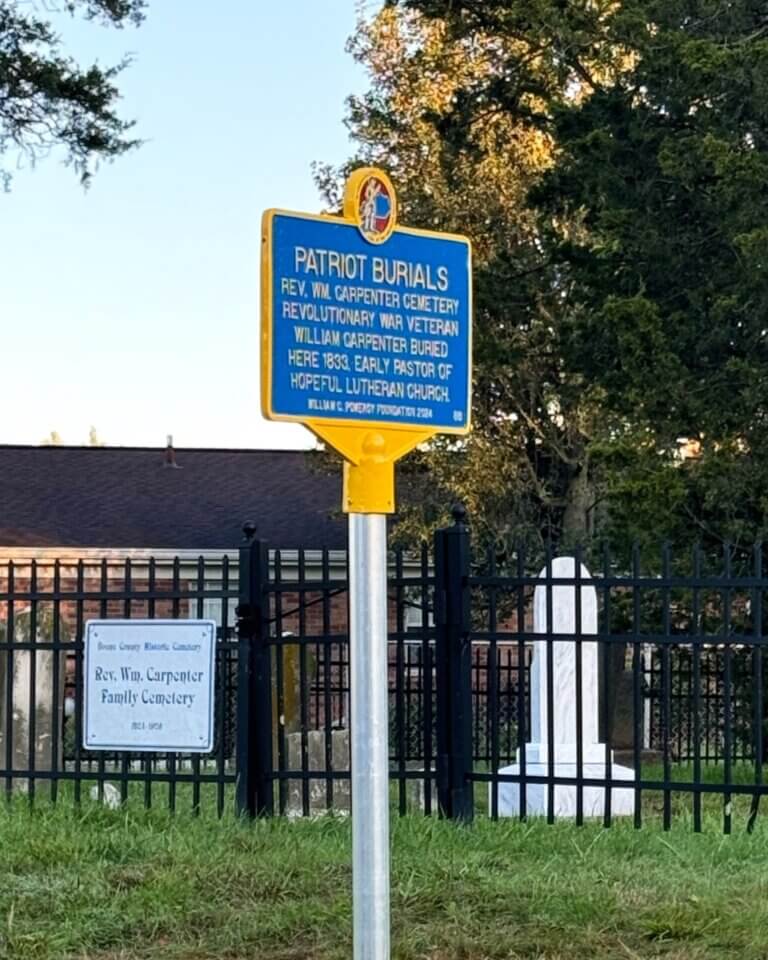PATRIOT BURIALS
- Program
- Subject
- Location
- Lat/Long
- Grant Recipient
-
Patriot Burials®
-
Cemetery, People, Site
- 54 Circle Dr, Florence, KY 41042, USA
- 38.991345930812, -84.629813064628
-
Kentucky Society - Sons of the American Revolution
PATRIOT BURIALS
Inscription
PATRIOT BURIALSREV. WM. CARPENTER CEMETERY
REVOLUTIONARY WAR VETERAN
WILLIAM CARPENTER BURIED
HERE 1833. EARLY PASTOR OF
HOPEFUL LUTHERAN CHURCH.
WILLIAM G. POMEROY FOUNDATION 2024
The origins of the American Revolution can be traced back to 1775, when the first shots were fired between colonial and British forces at the Battle of Lexington and Concord. Soon after, the American Colonies declared their independence from Great Britain on July 4, 1776. As the newly formed United States went to war with Great Britain, hundreds of men across the Thirteen Colonies joined the fight. These men came from different walks of life; some were farmers, others were tradesmen, lawyers, doctors and merchants. Despite their differences they desired the same thing: freedom and independence. Colonial forces faced severe challenges, including lack of supplies and military training; however, in the face of obstacles they were undeterred. After nearly 8 years the colonies defeated Great Britain and successfully achieved their independence. It is important to remember the lives and sacrifices made by those who fought for American freedom.
The Reverend William Carpenter Cemetery is the final resting place of the community’s early residents and members of the Carpenter family. Among those buried here is William Carpenter, who served during the Revolutionary War.
A detailed account of his life appears in Volume XV of The Evangelical Quarterly Review, edited by M. L. Stoever, and published in 1864. Beginning on page 129, a posthumous biography details his service during the Revolutionary War, stating:
“In 1778, in the 16th year of his age, we find him with his brother entering the Revolutionary Army, filled with patriotic ardor, and deeply interested in the principles, involved in the issue. With scarcely a single exception our Lutheran population, at that early day, identified themselves with the interests of freedom, and were ever ready to pledge “their lives, their fortunes and their sacred honor” in support of the holy cause… Young Carpenter was present at the surrender of Lord Cornwallis, and participated in other memorable scenes in our early history…. He often, in after life, recounted the hardships which he and his fellow-soldiers endured and the great privations which they suffered.”
While primary sources don’t confirm the exact events of his time during the War, they do confirm he answered the call to service, as his name appears in the “List of Classes in Culpeper County” for January, 1781, which is held in the collections of the Library of Virginia.
Following the War, William Carpenter became a minister of the Lutheran Church. His obituary, published in 1833 in the Lutheran Observer read:
“Died, in Boon County, Kentucky, on the 18th February, 1833, the Rev. Mr. Carpenter, minister of the Lutheran church. He entered the ministry at 24 years of age and served the church in Madison co., Virginia, between 20 and 30 years. He removed thence to Kentucky, where he labored as a pioneer in our church for about 20 years. He was nearly 80 years of age at the time of his death.”
Though William Carpenter’s original gravestone has since broken and become illegible, an image of his marker appears on page 160 of Emma Rouse Lloyd’s, “Clasping Hands with Generations Past,” published in 1832, which shows what it once looked like. In addition, the Daughters of the American Revolution placed a bronze tablet footstone to mark the site of his burial.

